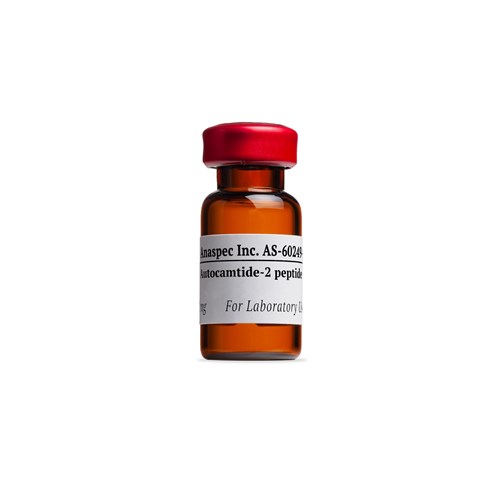epsilon-V1-2, PKCe Inhibitor - 1 mg
- Cat.Number : AS-62186
- Manufacturer Ref. :
-
Availability :
In production
Alternative choices
This peptide is derived from residues 14-21 of protein kinase C C2 (εPKC C2). This peptide specifically inhibits εPKC by disrupting PKC binding to its receptor, RACK2. εPKC mediated signal transduction plays a role in cell proliferation, differentiation, and apoptosis.
Pyroglutamyl (pGlu) peptides may spontaneously form when either Glutamine (Q) or Glutamic acid (E) is located at the sequence N-terminus. The conversion of Q or E to pGlu is a natural occurrence and in general it is believed that the hydrophobic γ-lactam ring of pGlu may play a role in peptide stability against gastrointestinal proteases. Pyroglutamyl peptides are therefore considered a normal subset of such peptides and are included as part of the peptide purity during HPLC analysis.
Specifications
| Chemistry | |
| Sequence one letter code |
|
|---|---|
| Sequence three letter code |
|
| Molecular Formula |
|
| Molecular Mass/ Weight |
|
| Modification | |
| Conjugation |
|
| Quantity & Purity | |
| Purity |
|
| Storage & stability | |
| Form |
|
| Storage Conditions |
|
| Activity | |
| Application | |
| Biomarker Target | |
| Research Area | |
| Sub-category Research Area | |
| Usage |
|
| Source | |
| Source / Species |
|
You may also be interested in the following product(s)



Kinase Substrates Library, Group I, biotinylated, 180 distinct peptide mixtures - 1 Set
Citations
Peptides derived from the C2 domain of protein kinase C epsilon (epsilon PKC) modulate epsilon PKC activity and identify potential protein-protein interaction surfaces.
J Biol Chem . 2006 Dec 02 ; 282 4113 | DOI : 10.1074/jbc.M608521200.
- R. Brandman
Sigma-1 receptor-induced increase in murine spinal NR1 phosphorylation is mediated by the PKCα and var epsilon, but not the PKCζ, isoforms
Neurosci Lett. . 2010 Apr 22 ; 477(2) 95 | DOI : 10.1016/j.neulet.2010.04.041
- D. Roh

